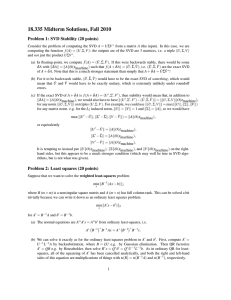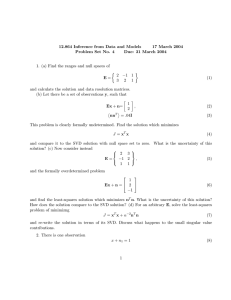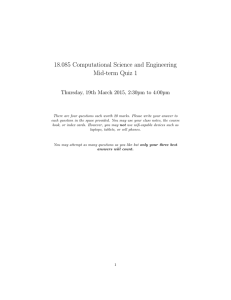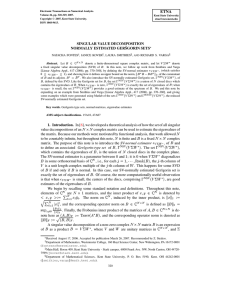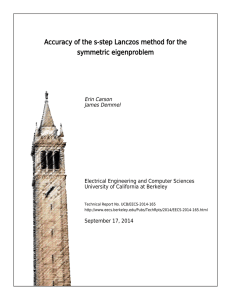18.335 Midterm Solutions, Fall 2010 Problem 1: SVD Stability (20 points)
advertisement
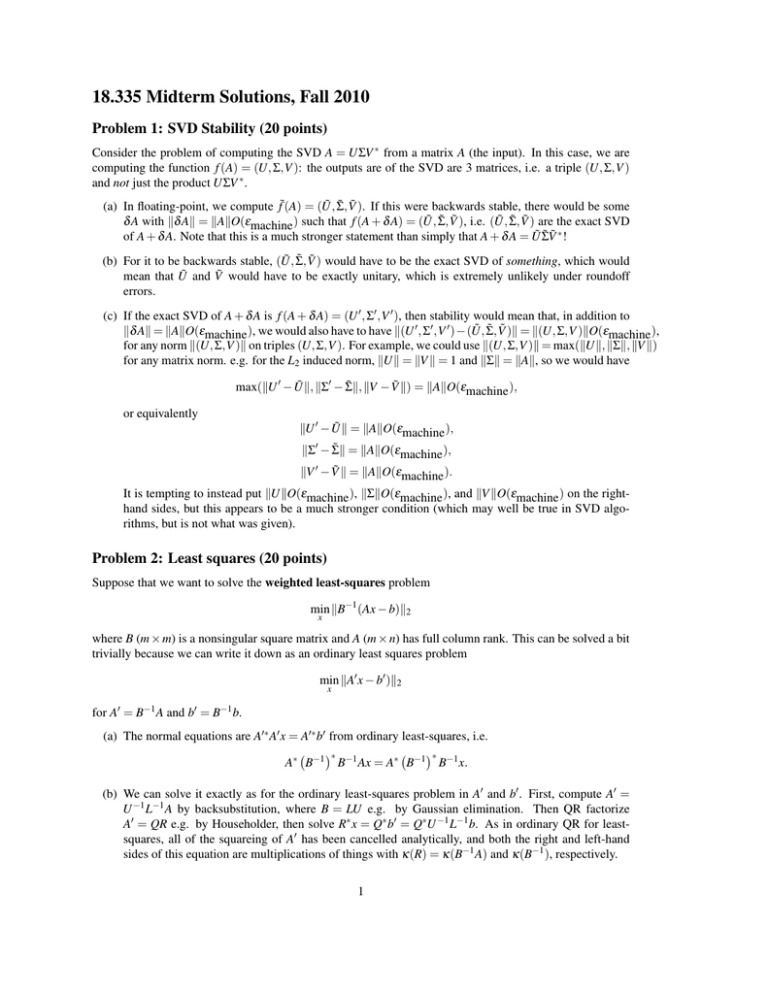
18.335 Midterm Solutions, Fall 2010 Problem 1: SVD Stability (20 points) Consider the problem of computing the SVD A = UΣV ∗ from a matrix A (the input). In this case, we are computing the function f (A) = (U, Σ,V ): the outputs are of the SVD are 3 matrices, i.e. a triple (U, Σ,V ) and not just the product UΣV ∗ . (a) In floating-point, we compute f˜(A) = (Ũ, Σ̃, Ṽ ). If this were backwards stable, there would be some δ A with kδ Ak = kAkO(εmachine ) such that f (A + δ A) = (Ũ, Σ̃, Ṽ ), i.e. (Ũ, Σ̃, Ṽ ) are the exact SVD of A + δ A. Note that this is a much stronger statement than simply that A + δ A = Ũ Σ̃Ṽ ∗ ! (b) For it to be backwards stable, (Ũ, Σ̃, Ṽ ) would have to be the exact SVD of something, which would mean that Ũ and Ṽ would have to be exactly unitary, which is extremely unlikely under roundoff errors. (c) If the exact SVD of A + δ A is f (A + δ A) = (U 0 , Σ0 ,V 0 ), then stability would mean that, in addition to kδ Ak = kAkO(εmachine ), we would also have to have k(U 0 , Σ0 ,V 0 )−(Ũ, Σ̃, Ṽ )k = k(U, Σ,V )kO(εmachine ), for any norm k(U, Σ,V )k on triples (U, Σ,V ). For example, we could use k(U, Σ,V )k = max(kUk, kΣk, kV k) for any matrix norm. e.g. for the L2 induced norm, kUk = kV k = 1 and kΣk = kAk, so we would have max(kU 0 − Ũk, kΣ0 − Σ̃k, kV − Ṽ k) = kAkO(εmachine ), or equivalently kU 0 − Ũk = kAkO(εmachine ), kΣ0 − Σ̃k = kAkO(εmachine ), kV 0 − Ṽ k = kAkO(εmachine ). It is tempting to instead put kUkO(εmachine ), kΣkO(εmachine ), and kV kO(εmachine ) on the righthand sides, but this appears to be a much stronger condition (which may well be true in SVD algorithms, but is not what was given). Problem 2: Least squares (20 points) Suppose that we want to solve the weighted least-squares problem min kB−1 (Ax − b)k2 x where B (m × m) is a nonsingular square matrix and A (m × n) has full column rank. This can be solved a bit trivially because we can write it down as an ordinary least squares problem min kA0 x − b0 )k2 x for A0 = B−1 A and b0 = B−1 b. (a) The normal equations are A0∗ A0 x = A0∗ b0 from ordinary least-squares, i.e. ∗ ∗ A∗ B−1 B−1 Ax = A∗ B−1 B−1 x. (b) We can solve it exactly as for the ordinary least-squares problem in A0 and b0 . First, compute A0 = U −1 L−1 A by backsubstitution, where B = LU e.g. by Gaussian elimination. Then QR factorize A0 = QR e.g. by Householder, then solve R∗ x = Q∗ b0 = Q∗U −1 L−1 b. As in ordinary QR for leastsquares, all of the squareing of A0 has been cancelled analytically, and both the right and left-hand sides of this equation are multiplications of things with κ(R) = κ(B−1 A) and κ(B−1 ), respectively. 1 I should mention that there are even more efficient/accurate ways to solve this problem than doing ordinary least-squares with B−1 A. LAPACK provides something called a “generalized QR” factorization A = QR, B = QT Z for this, where Z is also unitary and T is upper triangular, to avoid the necessity of a separate LU factorization of B. Problem 3: Eigenvalues (20 points) (a) Suppose our initial guess is expanded in the eigenvectors qi as x1 = c1 q1 + c2 q2 + · · · (where for a random x1 all the ci are 6= 0 in general), in which case xn = (c1 λ1n q1 + c2 λ2n q2 + · · · )/k · · · k. If |λ1 | = |λ2 |, then the q1 and q2 terms will grow at the same rate, and it will never be dominated by q1 alone—xn will “bounce around” in a two-dimensional subspace spanned by q1 and q2 . Note that the algorithm will not in general converge: for example, if λ2 = −λ1 , then the relative signs of the q1 and q2 terms will oscillate. (More generally, λ2 = eiφ λ1 for some phase φ , and the q2 term will rotate in phase by φ relative to q1 on each step.) However, if λ1 = λ2 , then xn = [λ1n (c1 q1 + c2 q2 ) + O(|λ3 /λ1 |n )]/k · · · k, and xn therefore becomes parallel to c1 q1 + c2 q2 as n → ∞ (assuming |λ3 | < |λ1 |). But both q1 and q2 are eigenvectors with the same eigenvalue λ1 , so c1 q1 + c2 q2 is also an eigenvector of λ1 . Therefore, this is not a problem: we still get an eigenvector of λ1 . Equivalently, all of the eigenvectors for λ = λ1 form a subspace which is magnified relative to other eigenvalues by multiplying repeatedly by A, as long as other eigenvalues 6= λ1 have smaller magnitude. (b) Applying Lanczos to (A − µI)2 is computationally easy because we just need to multiply by (A − µI) twice in each step (cheap if A is sparse, cost ∼ #nonzeros). However, we have squared the condition number of A − µI, and thus we square the rate at which the largest-|λ | eigenvalues appear in the Krylov space, correspondingly slowing the rate (~ doubling the number of iterations) at which we get the smallest eigenvalue (the one closest to µ), and exacerbating problems with roundoff errors and ghost eigenvalues. On the other hand, (A − µI)−1 does not square any condition numbers, since the desired eigenvalue is now the largest-magnitude one, there should be no problem with ghost eigenvalues or roundoff (from homework) and Lanczos should converge well. However, we now have to multiply by (A − µI)−1 at each step, which means that on each step we need to solve a linear system with A − µI. If A is amenable to sparse-direct factorization, then we can do this once and re-use it throughout the Lanczos process (only somewhat slower than multiplying by A repeatedly, since the sparse-direct factorization generally loses some sparsity). If sparse-direct solvers are impractical and we have to use an iterative solver like GMRES etcetera, then we have the expense of repeating this iterative process on each step of Lanczos. Because of these tradeoffs, neither method is ideal for computing interior the eigenvalue closest to µ—computing interior eigenvalues is tricky. 2
